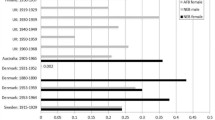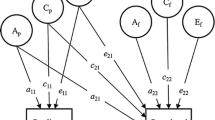Abstract
On the assumption that genetic inheritage and experience during adolescence influence the taste for children, the characteristics of a couple's parents may be used to improve on the explanation of fertility which can be obtained from variables that only refer to the couple itself. We find that in Israel fertility depends positively on the mother's siblings and negatively on the grandfathers' wage, but apparently does not depend on the father's siblings. Since fertility also depends positively on the mother's predicted wage, the number of children is positively related to improvements in the economic achievements from one generation to the next.
Similar content being viewed by others
References
Becker GS (1960) An economic analysis of fertility. In: Demographic and economic change in developed countries. Universities — National Bureau Conference Series 11. Princeton University Press, Princeton
Becker GS (1981) A treatise on the family. Harvard University Press, Cambridge
Becker GS, Lewis HG (1973) On the interaction between quantity and quality of children. J Polit Econ 81:S279–S288
Becker GS, Tomes N (1979) An equilibrium theory of the distribution of income and intergenerational mobility. J Polit Econ 87:1153–1189
Ben-Porath Y (1973) Economic analysis of fertility in Israel: Point and counterpoint. J Polit Econ 81:S202–S233
Ben-Porath Y (1975) First-generation effects on second-generation fertility. Demography 12:397–405
Berent J (1953) Relationship between family sizes of two successive generations. Milbank Mem Fund Q, pp 39–50
Duesenberry JS (1966) Income, saving, and the theory of consumer behavior. Harvard University Press, Cambridge
Duncan OD, Freedman R, Coble FM, Slesinger DP (1965) Marital fertility and size of family of orientation. Demography 2:508–515
Easterlin RA (1966) On the relation of economic factors to recent and projected fertility changes. Demography 3:131–151
Easterlin RA (1968) Population, labor force, and long swings in economic growth. Columbia University Press, New York
Easterlin RA (1973) Relative economic status and the American fertility swing. In: Sheldon EB (ed) Family economic behavior: problems and prospects. JB Lippencott, Philadelphia
Gronau R (1976) The allocation of time of Israeli women. J Polit Econ 84:S201–S220
Harell FE (1985) The logist procedure. In: Sugi, Supplemental Library User's Guide (SAS), Version 5
Heckman JJ (1976) The common structure of models of truncation, sample selection, and limited dependent variables and a simple estimator for such models. Ann Econ Soc Measur 5:475–492
Heckman JJ (1979) Sample selection bias as a specification error. Econometrica 47:153–161
Israeli Central Bureau of Statistics (1977) Labour mobility survey 1974. Special Series No. 544
Lee LF (1983) Generalized econometric models with selectivity. Econometrica 51:507–512
Mincer J (1963) Market prices, opportunity costs, and income effects. In: Christ C et al. (eds) Measurement in economics: Studies in mathematical economic and econometrics in memory of Yehuda Grunfeld. Stanford University Press, Stanford
Mincer J (1974) Schooling experience and earnings. Columbia University Press, New York
Pindyck RS, Rubinfeld DL (1976) Econometric models and economic forecasts. McGraw-Hill, London
Sanderson WC (1976) On two schools of the economics of fertility. Popul Dev 2:469–477
Schultz TP (1969) An economic model of family planning and fertility. J Polit Econ 77:153–180
Schultz TP (1986) The value and allocation of time in high income countries: implications for fertility. Econ Growth Center, Yale University
Tyree A (1981) Socio-economic occupational status in Israeli society. Megamoth 29 (Hebrew)
Author information
Authors and Affiliations
Additional information
We wish to thank the referees and the managing editor for helpful suggestions.
Rights and permissions
About this article
Cite this article
Danziger, L., Neuman, S. Intergenerational effects on fertility Theory and evidence from Israel. J Popul Econ 2, 25–37 (1989). https://doi.org/10.1007/BF00599178
Received:
Accepted:
Issue Date:
DOI: https://doi.org/10.1007/BF00599178




